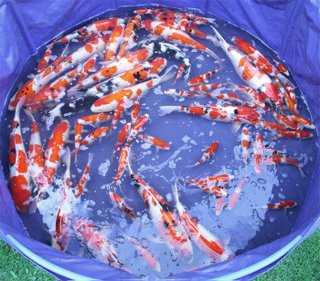
Piscinarii.com has kindly given this blog
Koi Carp a mention, so I thought I would share a little link love and return the favour. This is not difficult though as Piscinarii.com is one of the most entertaining and interesting fish keeping blogs out there. Recent posts have covered everything from movies and celebrities, through to how religion can influence keeping fish. This blog comes from the Philippines, a country with many tropical fish enthusiasts and a growing number of koi fans. It has been reported recently that their fish farmers have been considering diversifying into koi breeding due to new demand and the high costs of importation. While it's easy to get envious of their climate, there are a few unique problems that their koi keepers have to deal with, such as Typhons.
Piscinarii for those like me that didn't study Latin at school, is the name for a fish pond owner. Marcus Cicero used it to describe rich Roman citizens who were more interested in keeping their ornamental ponds than in politics. It became associated as a derisive term implying madness. Perhaps a modern alternative for someone with an obsessive interest would now be called an Otaku in Japanese, or more tongue in cheek for a koi fan, Koi Kichi. These terms though only relate to a persons deep interest in the subject, whereas Cicero's use of Piscinarii was to poke fun at the rich and powerful whose ponds were status symbols for showing off.
The Romans became quite adept at keeping fish in ponds they called Piscinae, but it was found easier and more profitable to grow freshwater fish for food. Sea fish were preferred though so a divide grew between salt water ponds (Piscinae Salsae), which were expensive and mostly for novelty value and freshwater ponds that were a source of food for the average Roman citizen. It was written in 37 BC that a ponds appeal was to the eye rather than the purse, which it emptied rather than being filled. This is something many koi keepers can identify with.
"For in the first place they are built at great cost, in the second place they are stocked at great cost, and in the third place they are kept up at great cost"
With Roman nobility trying to out do each other in the late republic, they would build grand villas by the sea with fishponds in coves and inlets, much like the swimming pools at millionaires pads today. Many were built from an early concrete that set underwater and used a network of channels with brass grates to regulate the level and salinity.
The photo above shows part of a saltwater fishpond that belonged to the Emperor Tiberius. This pond mixes with the sea at high tide, but like many Roman fishponds of the time, it's mainly brackish as it's diluted by natural springs in the cave. There's a narrow channel that connects the sea to the pond and allows fish to enter but not escape. The fish must have thought they were swimming up stream, attracted by the freshwater. It has been suggested that the four tanks in the centre were used to house fish that if put together would eat each other but could just have easily been used to place fish for easy catching. People probably slaves, were employed to catch food for the fish and sometimes they would even buy it from the market.
How long they managed to keep these fish alive I don't know, but it's quite amazing to think that around the time of Jesus, and without all the modern equipment we have today, people were enjoying a similar hobby. Although it's well known that the Chinese have kept ornamental fish for thousands of years, it's most likely that the Romans were the first to spread the use of aquaculture throughout Europe, with it later being continued by medieval monks.
Labels: fishkeeping, ponds








 To avoid this possibly becoming like watching paint dry I will update when anything significant happens. As well as a test of Aqualibrium this will also be a good opportunity to explain and try out certain theories of how a koi pond filter works and how you can improve yours.
To avoid this possibly becoming like watching paint dry I will update when anything significant happens. As well as a test of Aqualibrium this will also be a good opportunity to explain and try out certain theories of how a koi pond filter works and how you can improve yours.
















